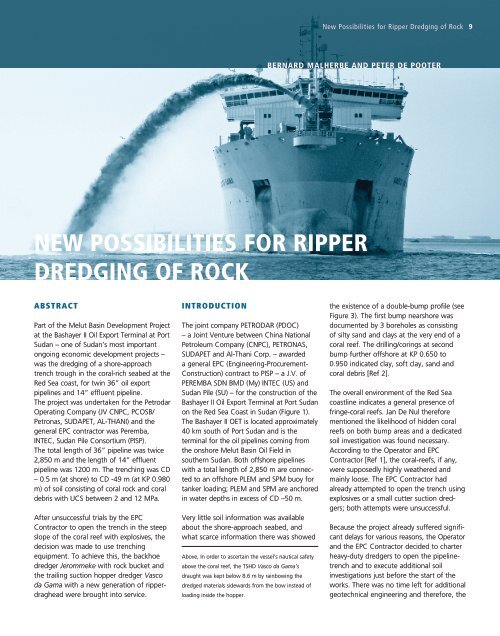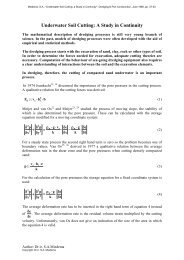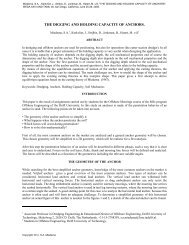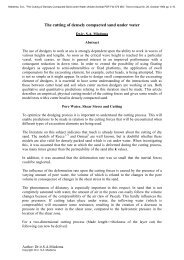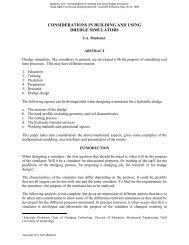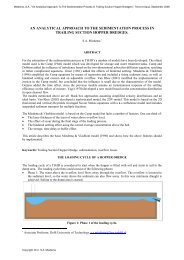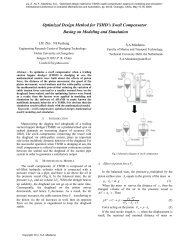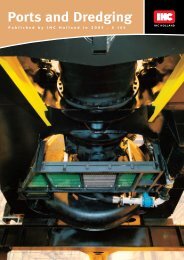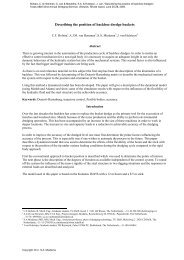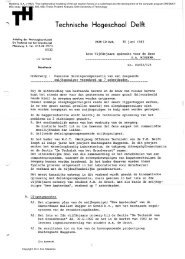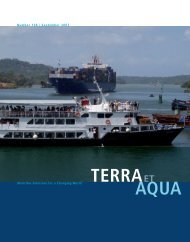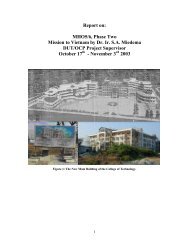The rock manual - Dredging Engineering Research Laboratory
The rock manual - Dredging Engineering Research Laboratory
The rock manual - Dredging Engineering Research Laboratory
You also want an ePaper? Increase the reach of your titles
YUMPU automatically turns print PDFs into web optimized ePapers that Google loves.
New Possibilities for Ripper <strong>Dredging</strong> of Rock 9BERNARD MALHERBE AND PETER DE POOTERNEW POSSIBILITIES FOR RIPPERDREDGING OF ROCKABSTRACTPart of the Melut Basin Development Projectat the Bashayer II Oil Export Terminal at PortSudan – one of Sudan’s most importantongoing economic development projects –was the dredging of a shore-approachtrench trough in the coral-rich seabed at theRed Sea coast, for twin 36” oil exportpipelines and 14” effluent pipeline.<strong>The</strong> project was undertaken for the PetrodarOperating Company (JV CNPC, PCOSB/Petronas, SUDAPET, AL-THANI) and thegeneral EPC contractor was Peremba,INTEC, Sudan Pile Consortium (PISP).<strong>The</strong> total length of 36” pipeline was twice2,850 m and the length of 14” effluentpipeline was 1200 m. <strong>The</strong> trenching was CD– 0.5 m (at shore) to CD -49 m (at KP 0.980m) of soil consisting of coral <strong>rock</strong> and coraldebris with UCS between 2 and 12 MPa.After unsuccessful trials by the EPCContractor to open the trench in the steepslope of the coral reef with explosives, thedecision was made to use trenchingequipment. To achieve this, the backhoedredger Jerommeke with <strong>rock</strong> bucket andthe trailing suction hopper dredger Vascoda Gama with a new generation of ripperdragheadwere brought into service.INTRODUCTION<strong>The</strong> joint company PETRODAR (PDOC)– a Joint Venture between China NationalPetroleum Company (CNPC), PETRONAS,SUDAPET and Al-Thani Corp. – awardeda general EPC (<strong>Engineering</strong>-Procurement-Construction) contract to PISP – a J.V. ofPEREMBA SDN BMD (My) INTEC (US) andSudan Pile (SU) – for the construction of theBashayer II Oil Export Terminal at Port Sudanon the Red Sea Coast in Sudan (Figure 1).<strong>The</strong> Bashayer II OET is located approximately40 km south of Port Sudan and is theterminal for the oil pipelines coming fromthe onshore Melut Basin Oil Field insouthern Sudan. Both offshore pipelineswith a total length of 2,850 m are connectedto an offshore PLEM and SPM buoy fortanker loading; PLEM and SPM are anchoredin water depths in excess of CD –50 m.Very little soil information was availableabout the shore-approach seabed, andwhat scarce information there was showedAbove, In order to ascertain the vessel’s nautical safetyabove the coral reef, the TSHD Vasco da Gama’sdraught was kept below 8.6 m by rainbowing thedredged materials sidewards from the bow instead ofloading inside the hopper.the existence of a double-bump profile (seeFigure 3). <strong>The</strong> first bump nearshore wasdocumented by 3 boreholes as consistingof silty sand and clays at the very end of acoral reef. <strong>The</strong> drilling/corings at secondbump further offshore at KP 0.650 to0.950 indicated clay, soft clay, sand andcoral debris [Ref 2].<strong>The</strong> overall environment of the Red Seacoastline indicates a general presence offringe-coral reefs. Jan De Nul thereforementioned the likelihood of hidden coralreefs on both bump areas and a dedicatedsoil investigation was found necessary.According to the Operator and EPCContractor [Ref 1], the coral-reefs, if any,were supposedly highly weathered andmainly loose. <strong>The</strong> EPC Contractor hadalready attempted to open the trench usingexplosives or a small cutter suction dredgers;both attempts were unsuccessful.Because the project already suffered significantdelays for various reasons, the Operatorand the EPC Contractor decided to charterheavy-duty dredgers to open the pipelinetrenchand to execute additional soilinvestigations just before the start of theworks. <strong>The</strong>re was no time left for additionalgeotechnical engineering and therefore, the


